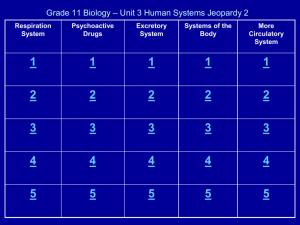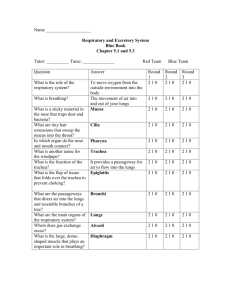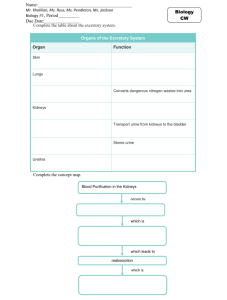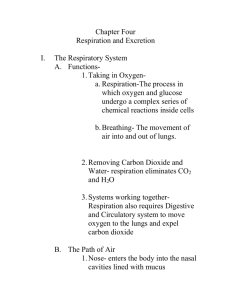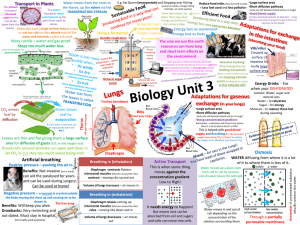Metabolic Wastes - SchoolWorld an Edline Solution
advertisement
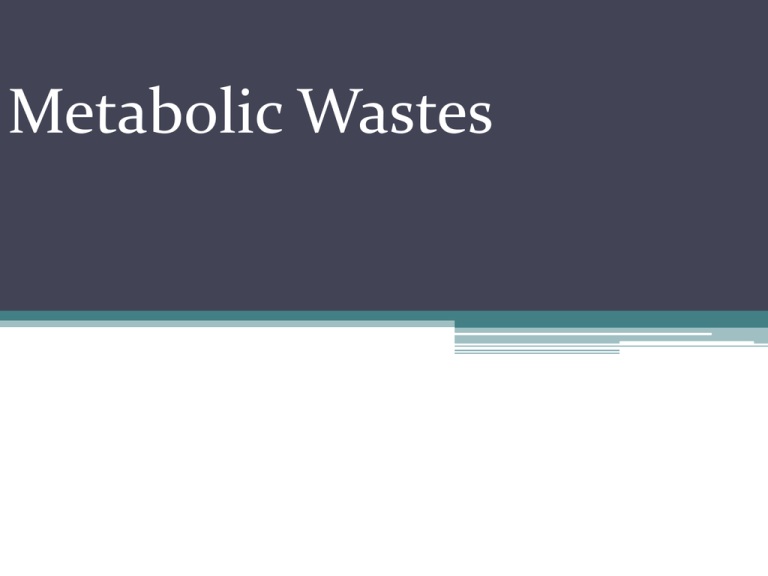
Metabolic Wastes Metabolic Wastes • Metabolic wastes are produced by cells when they metabolize (breakdown) glucose to produce energy. The 2 main metabolic wastes are CO2 and urea. Blood Gases • O2 AND CO2 gases dissolved in blood. The respiratory system is responsible for obtaining and moving blood gases in our bodies. Passage of Air • Air passes through the mouth and/or nasal passages into the trachea. The trachea carries the air to the bronchi (bronchial tubes). Each bronchus carries air to a lung. ▫ Note: The trachea also contains the larynx or “voice box”. The larynx produces sounds when air causes the vocal cords to vibrate. • Also the lungs are the main respiratory organs in humans. Other animals may use gills and/or skin for respiration. All of them: lungs, gills, and/or skin absorb O2 and release CO2. Passage of Air (Cont.) • As each bronchus enters the lung, it branches into smaller secondary bronchi which in turn branch into smaller tubes called bronchioles. • At the end of the bronchioles are small sac-like structures called alveoli. Alveoli are where gas exchange occurs. ▫ Note: the trachea, bronchi and bronchioles are all made of cartilage. CO2 Build Up in the Body • As CO2 is released from cells as a waste product, it builds up in the blood. When CO2 mixes with H20 it forms carbonic acid. • The breathing center of the brain monitors the amount of CO2 and O2 in the blood. The sensors for CO2 are in the Carotid arteries in the neck. • If the O2 levels are too low or the CO2 levels too high…..respiration rate and the volume of air taken in will increase. This will continue until the O2 and CO2 levels return to normal. The Breathing Process • INHALE means to inspire or breathe in. • EXHALE means to expire or breathe out. 3 Things Need to Happen to Inhale 1. diaphragm muscle contracts (pulls down) 2. abdominal muscles relax 3. intercostal muscles pull ribs out. • These 3 muscle movements increase the volume of the chest cavity (lowers the air pressure). The greater air pressure outside the lungs forces air into the lungs. 3 Things need to Happen to Exhale 1. diaphragm muscle relaxes (moves up) 2. abdominal muscles contract 3. intercostal muscles relax (ribs move in) • These movements decrease the volume of the chest cavity and force air out of lungs. Lung Capacity • Lung capacity if the total amount of air that our lungs can hold. • The average person has a lung capacity of 5 to 6 liters. • In normal breathing while at rest…the average person breathes about ½ liter per breath. • During exercise, 4 to 5 liters per breath may occur. • Also note that it is very hard to remove all air form a lung by breathing out. CO2 LAB • Lab objective: To use titration to determine the amount of CO2 released in expiration. • Titration is a method of determining how much of a substance is dissolved in a liquid. • It is done by adding a measured amount of a known substance until a color change occurs in an indicator solution. • We know that the amount of CO2 released in respiration is equal to the amount of O2 used in metabolism. • By measuring how much CO2 is released, we can calculate the amount of O2 used. • We will do this by measuring the amount of carbonic acid produced in H20 through which we will exhale. • (Use a straw!). Solutions Used in this Lab • Bromothymol solution is a pH indicator. In acids, it turns green/yellow. In a base it turns blue. • Sodium Hydroxide (NaOH) NaOH is a powerful base used in titration. Lab Safety • Goggles and aprons. NaOH is dangerous. • Do not suck in bromothymol solution • Wash hands if NaOH is on hands or skin. Urinary System • Urea contains the nitrogen wastes given off by cells. Theses wastes are toxic. • The liver collects these wastes and converts them to urea. The urea is then released into the blood and filtered out by the kidneys. 4 Basic Parts of the Urinary System • KIDNEYS ▫ The kidneys filter out nitrogen wastes and forms urine. • BLADDER ▫ The bladder collects and stores urine. • URETER ▫ The ureter is a tube that carries urine from the kidneys to the bladder. • URETHRA ▫ The urethra carries urine out of the body. Nitrogen Balance • N2 = nitrogenb • Our bodies must maintain a constant level of N2. Any N2 lost in the formation of urea must be replaced. How do we get N2? • We get N2 from the foods that we eat. Protein contains a lot of N2. Foods high in protein such as meats, corn, beans and nuts are great sources of N 2. Problem • When proteins (amino acids) are broken down, it produces NH3 (ammonia). • NH3 is highly toxic to our body. The liver must convert NH3 to urea so that it can be filtered out of the blood/body. Break Down of RBC’s • When RBC’s get old and wear out, they must be removed from the blood. The liver takes out the old RBC’s and breaks them down. Problem • When the RBC’s are broken down, they release toxic pigments into the bile. When bile is added to the small intestine, it is absorbed by the S.I. and then removed from the blood by the kidneys. The kidneys add the pigments to the urine. • THIS IS WHAT GIVES URINE its NICE YELLOW TINT! ▫ P.S. don’t eat yellow snow. • If the liver is not working correctly, it will release the pigments directly into the blood (not into the bile). Problem Cont. • The pigments in the blood will collect in the skin and in the sclera of the eyes. This will turn them yellow and we call this condition jaundice. How Does our Body Process Drugs? • Your body reacts to drugs the same way it reacts to anything else in our body…..it uses what it can and then breaks down and removes what is left. How does our Body Process Drugs? • Water soluble drugs like cocaine are easily broken down and quickly removed. • Fat soluble drugs like marijuana must be converted to a water soluble substance in order to be removed. How Does our Body Process Drugs? • The process of changing a fat soluble substance to a water soluble substance is called biotransformation. The liver is responsible for this. Problem • When some substances undergo biotransformation, they end up producing a toxic substance that can damage the organs of the body. Drug Testing • URINE TESTING ▫ Urine tests detect substances in the urine. It is the easiest and cheapest type of test but it is also the least accurate. • IMMUNOASSAY ▫ This test uses a blood sample. It uses antibodies to detect substances in the blood. It is more expensive but more accurate. • GAS CHROMOTOGRAPHY/MASS SPECTROMETER ▫ This test is very expensive and very accurate. It separates and identifies chemicals in a substance. ▫ (Urine, blood and hair can be used for this.)
